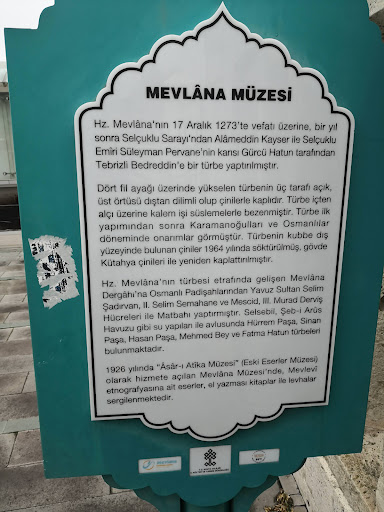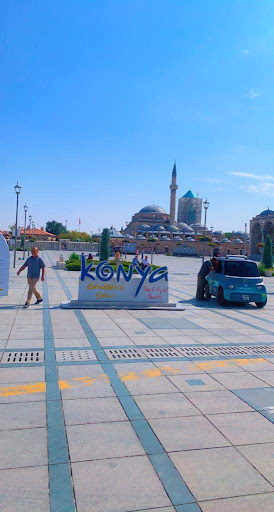Discovering the Spirit of Konya: The Mevlana Museum
Located in the heart of Konya, the Mevlana Museum is not just a historical site but a place of profound spiritual significance. It stands as a tribute to one of the world’s greatest poets and philosophers, Jalal ad-Din Muhammad Rumi—better known as Mevlana. This sacred space, with its iconic turquoise dome and tranquil gardens, attracts millions of visitors each year, offering a unique blend of history, culture, and spirituality.
A Place of Peace and Reflection
As you approach the Mevlana Museum, the serene atmosphere immediately sets the tone for your visit. The museum’s gardens are meticulously maintained, offering a peaceful retreat where you can sit and reflect amidst the beauty of roses and fountains. The sound of birdsong, combined with the gentle murmur of visitors, creates a calming ambiance that feels worlds away from the hustle and bustle of modern life.
The museum itself is an architectural masterpiece. Its most striking feature is the turquoise dome, which has become a symbol of Konya and a beacon of spirituality for people from all walks of life. The dome gleams in the sunlight, a reminder of the eternal wisdom and teachings of Mevlana that continue to inspire people worldwide.
The Legacy of Mevlana Rumi
Mevlana Rumi is celebrated not only in Turkey but across the globe for his timeless poetry and philosophy. Born in the 13th century, Rumi’s teachings emphasize love, tolerance, and unity—values that resonate deeply even today. His words, such as “Come, come, whoever you are,” invite people from all backgrounds and beliefs to find solace and connection through love and faith.
The Mevlana Museum was once the lodge of the Mevlevi Sufi order, which Rumi founded. It now serves as a place where visitors can learn about his life, teachings, and the whirling dervishes who embody his philosophy through their mesmerizing dance of devotion.
Exploring the Museum
Stepping into the museum feels like traveling back in time. The exhibits include Rumi’s personal belongings, ancient manuscripts, and artifacts that tell the story of the Mevlevi Sufi order. The intricate calligraphy, ornate carpets, and handcrafted musical instruments on display highlight the rich cultural heritage of the era.
One of the most awe-inspiring parts of the museum is the Tomb of Mevlana. Draped in a green velvet cloth adorned with gold inscriptions, Rumi’s sarcophagus is a place of deep reverence. Visitors often pause here to offer prayers or simply stand in silent contemplation, moved by the profound energy of the space.
Another highlight is the Semahane, the hall where the whirling dervishes performed their spiritual dance, known as the Sema. This ritual, a form of meditation in motion, symbolizes the journey of the soul toward divine love. Even without witnessing a live performance, the energy of the space is palpable.
A Symbol of Unity and Love
What makes the Mevlana Museum truly special is its ability to connect people. Regardless of religion, culture, or nationality, visitors are drawn to Rumi’s universal message of love and understanding. The museum’s multilingual displays and welcoming atmosphere reflect this inclusivity, ensuring that everyone feels at home.
Many visitors leave the museum feeling inspired, carrying with them a sense of peace and a renewed appreciation for the power of love and unity. For some, it’s a spiritual awakening; for others, it’s a chance to explore the rich history and traditions of Sufism.
Beyond the Museum
The Mevlana Museum is just one of many treasures in Konya. The city itself is steeped in history and culture, with landmarks like the Alaaddin Mosque, the Karatay Medrese, and the Ince Minaret Museum offering further glimpses into its glorious past.
If you have time, attend a live whirling dervish ceremony at the nearby Cultural Center, where the spiritual dance is performed in its full ceremonial context. It’s a mesmerizing experience that deepens your understanding of Rumi’s teachings and the Sufi...
Read moreYou have a great chance to visit an old city from Anatolia of 13th century. You will see the letters, original books, some beatiful simulations of old life and very traditional customs and dressings from the family and friends of Mevalana Celaleddin Rumi, a famous writer and philosopher in Anatolia. One will not forget this mysterious place in Konya... This museum (and pilgrimage center) commemorates the teachings of Celaleddin Rumi (later known as Mevlâna = my master). Rumi was a 13th-century Persian poet, Islamic scholar, theologian, and Sufi mystic originally from northeast Iran, but his influence transcends national borders and ethnic divisions. Rumi's works are written mostly in Persian, and occasionally in Turkish, Arabic, and Greek; his Masnavi (Mathnawi), composed in Konya, is considered one of the greatest poems of the Persian language. His works are widely read today by Iranians, Tajiks, Turks, Greeks, Pashtuns, other Central Asian Muslims. His teachings inspired the whirling dervishes. The pilgrimage site is surrounded by a garden; entry is through the Dervişan Kapısı (Gate of the Dervishes). The courtyard has an ablutions fountain in the center, with Rumi's mausoleum to the left and a former whirling dervish lodge to the right (which has been converted into a museum). At the entrance to the mausoleum, the Ottoman silver door bears the inscription, "Those who enter here incomplete will come out perfect". An outer room contains six sarcophagi belong to religious supporters who followed Rumi from Afghanistan. The sumptuously-decorated inner room (under the fluted dome) contains the tombs of Mevlâna (the largest), flanked by his son Sultan Veled and those of other eminent dervishes. They are all covered in beautifully embroidered velvet shrouds; Mevlâna's and Veled 's bear huge turbans, symbols of spiritual authority. Mevlâna's tomb dates from Seljuk times. The mosque and semahane (hall where whirling ceremonies were held), were added later by Ottoman sultans (Mehmet the Conqueror was a Mevlevi adherent and Süleyman the Magnificent made charitable donations to the order). The semahane to the left of the sepulchral chamber contains exhibits such as the original copy of the Mathnawi, Mevlâna's cape and other clothing, a 9th-century gazelle-skin Christian manuscript, a tiny copy of the Koran, and a casket containing strands of Mohammed's beard. The matbah (kitchen) of the lodge is in the southwest corner of the courtyard. It is furnished as it would have been in Mevlâna's day, with mannequins dressed as dervishes. The cells where the dervishes lived run along the northern and western sides of the courtyard. Inside are a host of ethnographic displays elucidating dervish life. Beside the museum is the Selimiye Cami, with a fluted dome of turquoise tiles. A visit early on a weekday can avoid some of the crowds visiting later in the day. The museum is open from 9am to 6pm (closes at 5pm Oct to Apr), with no entry fee; audio guide ₺10). Visitors to the mausoleum must don shoe coverings (provided free of charge) as a...
Read moreWalking in the Footsteps of Rumi – A Soulful Journey to the Mevlana Museum, Konya
The Mevlana Museum is not just a museum—it's a spiritual experience that resonates deeply with anyone who visits, regardless of faith or background. Located in the heart of Konya, Turkey, this is the resting place of Mevlana Jalal al-Din Rumi, the 13th-century Persian poet, mystic, and philosopher whose teachings on love and unity have inspired millions around the world.
From the moment you enter the gates, there’s a profound sense of peace. The courtyard is serene, lined with rose gardens and Ottoman-era architecture, and filled with the quiet hum of reverent visitors. The green-tiled dome of Rumi’s mausoleum, known as the Kubbe-i Hadra (Green Dome), is striking and instantly recognizable.
Inside, the mausoleum chamber is deeply atmospheric. Dim lighting, soft Sufi music, and reverent silence create a sacred environment. The sarcophagus of Rumi, beautifully draped and surrounded by the tombs of his family and followers, is the spiritual heart of the museum. The air is filled with a mix of awe, reverence, and contemplation.
The adjoining museum rooms are filled with ancient manuscripts, dervish garments, prayer beads, musical instruments, and detailed exhibits on Sufism and the Mevlevi Order (Whirling Dervishes). These offer a glimpse into the daily lives and spiritual practices of Sufi mystics.
One of the highlights was seeing the original handwritten copies of Rumi’s works and learning about his philosophy that emphasizes love, tolerance, and inner transformation.
Outside, there’s a peaceful dervish lodge, library, and kitchen exhibits that show how life was structured around devotion, learning, and community.
What I Loved Most: The spiritual ambiance—you don’t have to be religious to feel moved. The attention to detail in the exhibits and historical preservation. The beautiful calligraphy and poetry displayed throughout.
Suggestions: Go early in the morning or on a weekday to avoid crowds. Read a little about Rumi or Sufism beforehand to deepen the experience. Dress modestly out of respect for the spiritual setting.
Final Thoughts: The Mevlana Museum is the soul of Konya. It’s a journey into history, mysticism, and human connection. Whether you're a lover of poetry, a seeker of peace, or a traveler with curiosity, this place will leave a mark...
Read more


